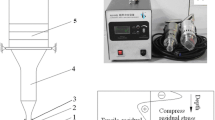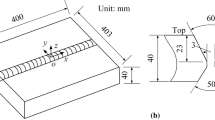Abstract
Ultrasonic impact treatment (UIT) was carried out on three specimens with different strengths and, to measure the subsurface stress distribution of the specimens, the layer-by-layer removal x-ray diffraction method was applied. The stress redistribution due to material removal was corrected by finite element analysis. The effect of material strength on the after-UIT subsurface stress was investigated. The results show that the UIT can cause a compressive stress layer with a depth of over 2.5 mm for specimens with different strengths, while the material strength has no significant effect on the depth of UIT-induced stress. The UIT-induced peak compressive stresses in the three specimens exceed the material yield strength, appearing at the depth of 0.2 mm beneath the surface and increasing with the increase of material yield strength. The ratio of UIT-induced peak compressive stress magnitude to material yield strength decreases with the increase of material yield strength.
Similar content being viewed by others
References
P. J. Withers, Residual stress and its role in failure, Reports on Progress in Physics, 70 (12) (2007) 2211–2264.
X. Jia, X. Hu, Z. Zhu and Y. Song, Fatigue strength predictions of FOD dents using ΔK threshold methods considering residual stresses, J. of Mechanical Science and Technology, 33 (1) (2019) 213–224.
J. Hensel, T. Nitschke-Pagel and K. Dilger, Residual stress-based fatigue design of welded structures, Materials Performance and Characterization, 7 (4) (2018) 630–642.
J. B. Jorgensen, B. F. Sorensen and C. Kildegaard, The effect of residual stresses on the formation of transverse cracks in adhesive joints for wind turbine blades, International Journal of Solids and Structures, 163 (2019) 139–156.
W. Guo, N. Ding, N. Xu, L. Liu, N. Li, J. Shi and C. L. Wu, Fracture analysis of a welded front axle tube structure from a minitruck, J. of Mechanical Science and Technology, 34 (1) (2020) 109–116.
C. Mi, J. Liu, X. Xiao, W. Li, X. Sun, X. Ming, C. Tao and Z. Ren, Random vibration fatigue life assessment and optimization of a train buffer beam considering welding residual stress, J. of Mechanical Science and Technology, 34 (3) (2020) 1071–1080.
A. Abdullah, M. Malaki and A. Eskandari, Strength enhancement of the welded structures by ultrasonic peening, Materials and Design, 38 (2012) 7–18.
T. Okawa, H. Shimanuki, Y. Funatsu, T. Nose and Y. Sumi, Effect of preload and stress ratio on fatigue strength of welded joints improved by ultrasonic impact treatment, Welding in the World, 57 (2013) 235–241.
Q. Geng and W. Wang, Experimental research on constant-current source ultrasonic strengthening characteristics of 7075- T651 aluminum alloy, J. of Mechanical Science and Technology, 33 (3) (2019) 1203–1209.
K. L. Yuan and Y. Sumi, Simulation of residual stress and fatigue strength of welded joints under the effects of ultrasonic impact treatment (UIT), International J. of Fatigue, 92 (2016) 321–332.
J. Foehrenbach, V. Hardenacke and M. Farajian, High frequency mechanical impact treatment (HFMI) for the fatigue improvement: numerical and experimental investigations to describe the condition in the surface layer, Welding in the World, 60 (4) (2016) 749–755.
X. H. Cheng, J. W. Fisher, H. J. Prask, T. Gnaupel-Herold, B. T. Yen and S. Roy, Residual stress modification by post-weld treatment and its beneficial effect on fatigue strength of welded structures, International J. of Fatigue, 25 (9–11) (2003) 1259–1269.
C. Liu, J. Shen, J. Yan, Q. Chu, J. Wang and Y. Zhao, Experimental investigations on welding stress distribution in thick specimens after postweld heat treatment and ultrasonic impact treatment, J. of Materials Engineering and Performance, 29 (3) (2020) 1820–1829.
C. Liu, Y. Yan, X. Cheng, C. Wang and Y. Zhao, Residual stress in a restrained specimen processed by post-weld ultrasonic impact treatment, Science and Technology of Welding and Joining, 24 (3) (2019) 193–199.
C. Liu, Q. Ge, D. Chen, F. Gao and S. Zou, Residual stress variation in a thick welded joint after ultrasonic impact treatment, Science and Technology of Welding and Joining, 21 (4) (2016) 624–631.
M. Khurshid, M. Leitner, Z. Barsoum and C. Schneider, Residual stress state induced by high frequency mechanical impact treatment in different steel grades-numerical and experimental study, International J. of Mechanical Sciences, 123 (2017) 34–42.
V. Savaria, H. Monajati, F. Bridier and P. Bocher, Measurement and correction of residual stress gradients in aeronautical gears after various induction surface hardening treatments, J. of Materials Processing Technology, 220 (2015) 113–123.
V. Savaria, F. Bridier and P. Bocher, Computational quantification and correction of the errors induced by layer removal for subsurface residual stress measurements, International J. of Mechanical Sciences, 64 (1) (2012) 184–195.
C. Liu, J. B. Shen, C. H. Lin, J. F. Wang and J. X. Wang, Effects of initial stress state on the subsurface stress distribution after ultrasonic impact treatment on thick specimens, The J. of Strain Analysis for Engineering Design (2020).
X. J. Yang, J. X. Zhou and X. Ling, Study on plastic damage of AISI 304 stainless steel induced by ultrasonic impact treatment, Materials and Design, 36 (2012) 477–481.
H. Gao, R. K. Dutta, R. M. Huizenga, M. Amirthalingam, M. J. M. Hermans, T. Buslaps and I. M. Richardson, Stress relaxation due to ultrasonic impact treatment on multi-pass welds, Science and Technology of Welding and Joining, 19 (6) (2014) 505–513.
Acknowledgments
This work is supported by the National Natural Science Foundation of China (51575251), the Natural Science Foundation of Jiangsu Province (BX2019071), and the Natural Science Foundation of the Jiangsu Higher Education Institutions of China (18KJA460002).
Author information
Authors and Affiliations
Corresponding author
Additional information
Chuan Liu is a Professor at Jiangsu University of Science and Technology, China, received his Ph.D. from Xi’an Jiaotong University, China, in 2009. His research interests include residual stress measurement and mitigation, finite element simulation on welding stress and deformation.
Rights and permissions
About this article
Cite this article
Liu, C., Shen, Jb., Lin, Ch. et al. Experimental investigation on the subsurface stress distributions in specimens with different strengths after ultrasonic impact treatment. J Mech Sci Technol 35, 2123–2129 (2021). https://doi.org/10.1007/s12206-021-0428-0
Received:
Revised:
Accepted:
Published:
Issue Date:
DOI: https://doi.org/10.1007/s12206-021-0428-0




